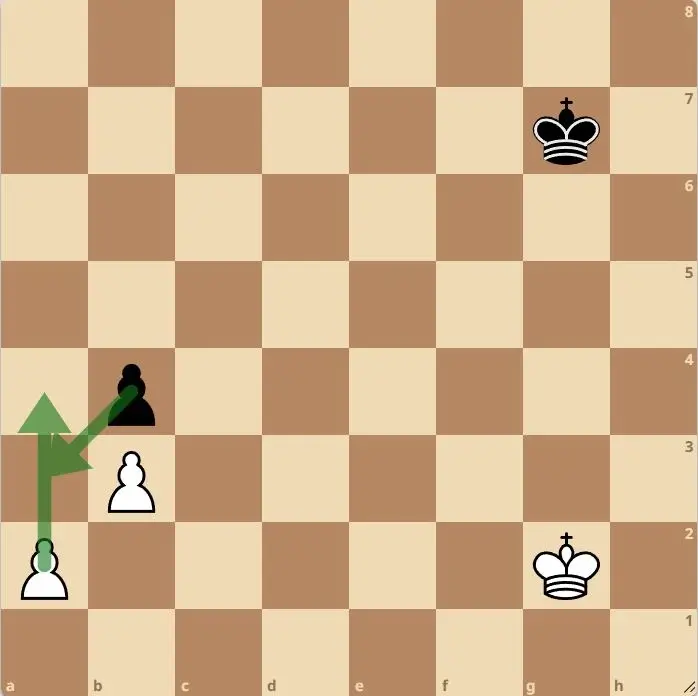What Is En Passant in Chess?
En passant is one of the most unique and often misunderstood rules in chess. It allows a pawn to capture an opponent’s pawn in a very specific situation that doesn’t follow the normal capturing pattern. While it doesn’t happen in every game, knowing how en passant works can help you avoid mistakes and even create tactical opportunities.
Have you ever seen a pawn get captured without landing on its square? Or been confused when your pawn suddenly disappears after a normal-looking move? That’s probably en passant in action.

What Does En Passant Mean?
The phrase “en passant” comes from French, meaning “in passing.” In chess, this term describes a very specific pawn capturing rule that happens in passing – when a pawn captures an opponent’s pawn that has just moved two squares forward, bypassing the capturing pawn’s attack square.
Unlike regular captures, where a pawn takes an enemy piece by moving onto its square, en passant allows your pawn to capture the opposing pawn as if it had only moved one square forward – effectively capturing it on the square it passed over, not the one it currently occupies.
How Does En Passant Work?
Here’s a simple explanation of how en passant works:
- Normally, pawns capture diagonally one square forward.
- But if your opponent moves a pawn two squares forward from its starting position, landing directly next to your pawn, you can capture it as if it had only moved one square forward.
- Your pawn moves diagonally into the square the opposing pawn skipped, and the opponent’s pawn is removed from the board.

This type of capture is only legal immediately after the two-square pawn move. If you wait even one turn, you can no longer play it.
Unlike typical captures where your piece lands on the square of the piece you’re taking, this capture is different. You capture the pawn without ending up on its square, which can make it confusing for newer players.
When Can You En Passant?
To use en passant, three specific conditions must be met. If even one is missing, the move is not legal.
1. The Opponent’s Pawn Must Move Two Squares Forward
The en passant rule only applies after your opponent advances a pawn two squares forward from its starting position. This usually happens early in the game when pawns are still on their second rank.
2. Your Pawn Must Be on the Right Rank and Next to It
- If you’re playing White, your pawn must be on the 5th rank.
- If you’re playing Black, your pawn must be on the 4th rank.
Your pawn must be directly next to the opponent’s pawn after its two-square move – either to the left or right.
3. You Must Capture Immediately
You can only capture on the very next move after the opponent plays the two-square pawn advance. If you delay even one move, the chance is gone forever.
Quick checklist for how to en passant:
- Opponent moves a pawn two squares from its starting square
- Your pawn is adjacent on the correct rank
- You play the capture immediately
Common Misconception
Many players think you can capture en passant anytime a pawn is next to yours – but that’s false.
The capture must be made immediately after the two-square move, or it’s no longer legal.
Why En Passant Exists
To understand why this rule exists, we need to go back several centuries.
The Historical Problem
In early versions of chess, pawns could only move one square at a time. But as the game evolved during the 13th to 16th centuries, players wanted a way to speed things up – so the two-square pawn advance on the first move was introduced.
This led to an unintended side effect:
A pawn could now bypass an enemy pawn’s attacking square, avoiding capture in a way that wasn’t previously possible.
The Solution
To prevent unfair evasions, the en passant rule was added. It allows players to still capture a pawn that tries to skip past a potential threat by using the new two-square move.
This way, a pawn can’t just “cheat” its way out of danger.
Why It’s Brilliant
The rule keeps pawn structure, timing, and tactics in balance. Without it, players could dodge confrontations too easily, changing the strategic nature of the game.
In short, this rule exists to preserve fairness – making sure that even with faster movement, pawns still respect the same tactical consequences.
Why It Matters
It may seem like a niche rule, but its value runs deeper than most players realize.
- It adds strategic depth, forcing players to think not just about material, but about timing and positioning.
- It introduces a rare element of timing pressure – you only have one move to decide whether to take the opportunity.
- Most importantly, it prevents unfair defensive skipping, keeping players honest when trying to dodge a capture by leaping two squares forward.
In a game where every move counts, this rule is a quiet reminder that chess rewards sharp observation, precision, and timing – and that even the smallest rules can carry serious weight.
To explore more special chess moves, visit this detailed guide.
En Passant in Your Own Games
If you’re wondering how to en passant effectively, the key is simple: pay attention to pawn moves, especially early in the game.

Tips for Spotting It:
- Watch for your opponent moving a pawn two squares forward.
- Check if your pawn is on the 5th rank (White) or 4th rank (Black) – right beside theirs.
- Ask yourself: does capturing improve your position, create an open file, or disrupt their pawn structure?
Tactical Uses:
- Disrupt connected pawns.
- Open lines for your rooks or queen.
- Create tactical threats or open diagonals for your bishops.
But remember – don’t wait. If you don’t play en passant immediately after the opportunity arises, you lose the right to play it forever.
Conclusion
The en passant rule might be strange at first glance, but it’s a beautifully balanced part of the game – an elegant fix to a centuries-old problem. It keeps the spirit of chess intact: fair, precise, and rich with opportunity for those who know the rules well.
It’s justice, served diagonally.
This rule reminds us that chess rewards knowledge, timing, and awareness. If you’d like to learn more tricky rules or sharpen your overall play, feel free to reach out to schedule a personalized lesson.
Additional Resources for Beginners:
Frequently Asked Questions
1. What is en passant in chess?
En passant is a special pawn capture rule in chess that allows a pawn to capture an opposing pawn that has just moved two squares forward from its starting position, bypassing the capturing pawn’s attack square. This capture must happen immediately on the very next move.
2. How does en passant work?
When your opponent moves a pawn two squares forward from its original square and it lands directly beside your pawn, you can capture that pawn as if it had moved only one square. Your pawn moves diagonally into the square the opponent’s pawn skipped over, and the opponent’s pawn is removed.
3. How to en passant?
To perform this capture, first ensure the opponent’s pawn has moved two squares forward and is adjacent to your pawn on the correct rank (5th for White, 4th for Black). Then, on your very next move, capture it by moving your pawn diagonally into the skipped square.
4. What does en passant mean?
“En passant” is French for “in passing.” It refers to the unique pawn capture in chess where a pawn captures an opponent’s pawn that has just passed beside it by moving two squares forward, capturing it “in passing” rather than on its landing square.
5. When can you en passant?
You can only en passant immediately after your opponent moves their pawn two squares forward from its starting position and lands beside your pawn. If you don’t capture on the very next move, the opportunity disappears.
